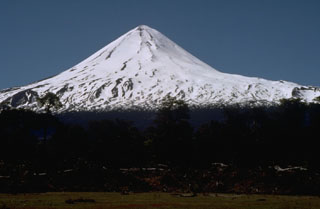Report on Llaima (Chile) — 19 March-25 March 2008
Smithsonian Institution / US Geological Survey
Weekly Volcanic Activity Report, 19 March-25 March 2008
Managing Editor: Sally Sennert.
Please cite this report as:
Global Volcanism Program, 2008. Report on Llaima (Chile) (Sennert, S, ed.). Weekly Volcanic Activity Report, 19 March-25 March 2008. Smithsonian Institution and US Geological Survey.
Llaima
Chile
38.692°S, 71.729°W; summit elev. 3125 m
All times are local (unless otherwise noted)
SERNAGEOMIN reported that fumarolic activity from the central pyroclastic cone in Llaima's main crater reactivated on 13 March and intensified during 15-17 March. Sulfur dioxide plumes rose to an altitude of 3.6 km (11,800 ft) a.s.l. and drifted E. People from nearby areas reported incandescence in the crater during 19-21 March. Incandescent material propelled from the crater was observed at night during 20-21 March.
Geological Summary. Llaima, one of Chile's largest and most active volcanoes, contains two main historically active craters, one at the summit and the other, Pichillaima, to the SE. The massive, dominantly basaltic-to-andesitic, stratovolcano has a volume of 400 km3. A Holocene edifice built primarily of accumulated lava flows was constructed over an 8-km-wide caldera that formed about 13,200 years ago, following the eruption of the 24 km3 Curacautín Ignimbrite. More than 40 scoria cones dot the volcano's flanks. Following the end of an explosive stage about 7200 years ago, construction of the present edifice began, characterized by Strombolian, Hawaiian, and infrequent subplinian eruptions. Frequent moderate explosive eruptions with occasional lava flows have been recorded since the 17th century.
Source: Servicio Nacional de Geología y Minería (SERNAGEOMIN)

